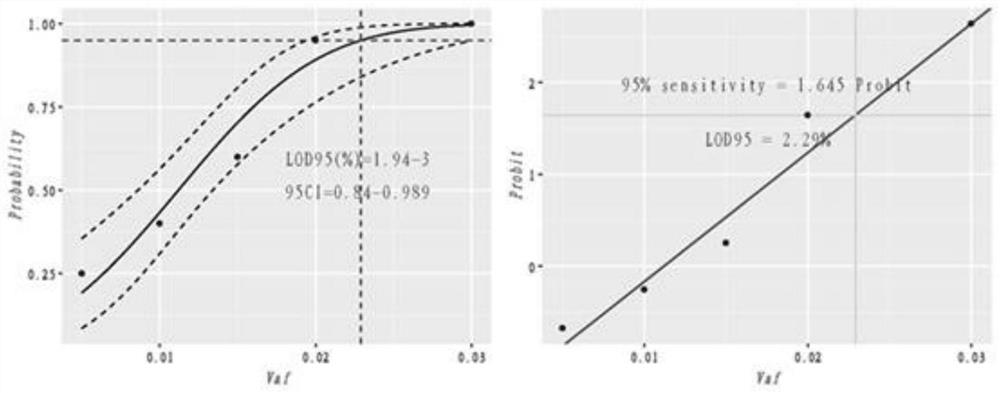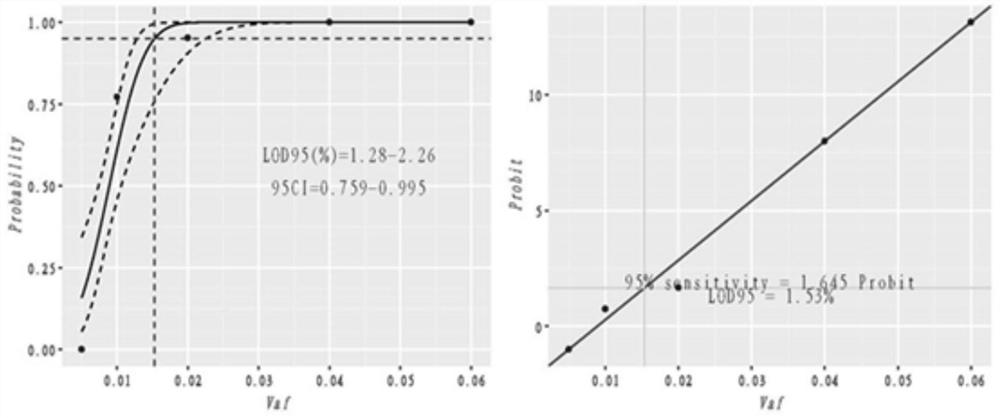Method and kit for detecting homologous recombination pathway gene mutation based on next-generation sequencing technology
A next-generation sequencing technology and homologous recombination technology, applied in the field of molecular detection, can solve problems such as genome instability
- Summary
- Abstract
- Description
- Claims
- Application Information
AI Technical Summary
Problems solved by technology
Method used
Image
Examples
Embodiment 1
[0063] Example 1. Obtaining the Gene Sequences of the Tumor Samples and Blood Cell Samples of the Kit of the Application
[0064] 1. Fragmentation of FFPE gDNA and BC gDNA
[0065] The concentration of FFPE DNA and BC DNA was diluted to 6ng / μL. Take 55 μL for fragmentation. CovarisM220 is recommended for the fragmentation instrument. Set the equipment parameters as shown in the table below for fragmentation
[0066] parameter Volume: 55μL / sample Target BP(Peak) 200 Peak Incident Power(W) 75 Duty Factor 10% Cycles per Burst 200 Treatment time(S) 270s(FFPE DNA) / 6min(BC DNA)
[0067] 2. Library Construction
[0068] 2.1 End Repair & Add A:
[0069] 2.1.1 Configure the end repair & add A reaction system according to the table, vortex to mix, and briefly centrifuge.
[0070] components Volume (μL) Fragmented DNA X end repair enzyme 2 end repair buffer 10 nuclease free water make up 48 total...
Embodiment 2
[0176] Example 2. Detection of pathogenicity of homologous recombination gene in the kit of the present application
[0177] 1. Identification of homologous recombination gene SNV and indel
[0178] Use Mutect2 software to analyze the comparison results of the tumor sample obtained in Example 1 and the normal sample next-generation sequencing gene-panel, identify the somatic mutation and germline mutation in the tumor sample, and use the annovar software to analyze the somatic cell identified by Mutect2 Mutations and germline mutations are annotated, and those that meet the following criteria are disease-causing mutations:
[0179] 1) The number of sequences covering the mutation site is greater than 200;
[0180] 2) The frequency of mutation is greater than 5%;
[0181] 3) It is recorded as a pathogenic mutation in Clinvar, or the mutation type is fs, truncate, or splice.
[0182] 2. Homologous recombination gene copy number variation detection
[0183] Use the cnvkit sof...
Embodiment 3
[0184] Example 3. Calculation of the mutation feature score of the kit of the present application
[0185] Somatic mutations are induced by different external or internal factors, including errors in DNA replication mechanism, induction of internal or external factors, modification of DNA modification enzymes, or failure of DNA repair enzymes. Somatic mutations caused by different factors will have different combinations of mutation types, which is the so-called mutation signature. It has been reported that Signature 3 in the mutation signature has a very strong correlation with homologous recombination pathway defects.
[0186] For the filtering results of the SNVs obtained in Example 2, the sigma software was used to calculate the score of the mutation feature related to homologous recombination.
PUM
 Login to View More
Login to View More Abstract
Description
Claims
Application Information
 Login to View More
Login to View More - R&D
- Intellectual Property
- Life Sciences
- Materials
- Tech Scout
- Unparalleled Data Quality
- Higher Quality Content
- 60% Fewer Hallucinations
Browse by: Latest US Patents, China's latest patents, Technical Efficacy Thesaurus, Application Domain, Technology Topic, Popular Technical Reports.
© 2025 PatSnap. All rights reserved.Legal|Privacy policy|Modern Slavery Act Transparency Statement|Sitemap|About US| Contact US: help@patsnap.com



